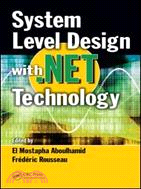System Level Design With.NET Technology
商品資訊
ISBN13:9781439812112
出版社:CRC Press UK
作者:El Mostapha Aboulhamid (EDT); Frederic Rousseau (EDT)
出版日:2009/09/28
裝訂/頁數:精裝/320頁
定價
:NT$ 7475 元優惠價
:90 折 6728 元
若需訂購本書,請電洽客服 02-25006600[分機130、131]。
商品簡介
目次
相關商品
商品簡介
The first book to harness the power of .NET for system design, System Level Design with .NET Technology constitutes a software-based approach to design modeling verification and simulation. World class developers, who have been at the forefront of system design for decades, explain how to tap into the power of this dynamic programming environment for more effective and efficient management of metadata—and introspection and interoperability between tools.
Using readily available technology, the text details how to capture constraints and requirements at high levels and describes how to percolate them during the refinement process. Departing from proprietary environments built around System Verilog and VHDL, this cutting-edge reference includes an open source environment (ESys.NET) that readers can use to experiment with new ideas, algorithms, and design methods; and to expand the capabilities of their current tools. It also covers:
Modeling and simulation—including requirements specification, IP reuse, and applications of design patterns to hardware/software systems
Simulation and validation—including transaction-based models, accurate simulation at cycle and transaction levels, cosimulation and acceleration technique, as well as timing specification and validation
Practical use of the ESys.NET environment
Worked examples, end of chapter references, and the ESys.NET implementation test bed make this the ideal resource for system engineers and students looking to maximize their embedded system designs.
Using readily available technology, the text details how to capture constraints and requirements at high levels and describes how to percolate them during the refinement process. Departing from proprietary environments built around System Verilog and VHDL, this cutting-edge reference includes an open source environment (ESys.NET) that readers can use to experiment with new ideas, algorithms, and design methods; and to expand the capabilities of their current tools. It also covers:
Modeling and simulation—including requirements specification, IP reuse, and applications of design patterns to hardware/software systems
Simulation and validation—including transaction-based models, accurate simulation at cycle and transaction levels, cosimulation and acceleration technique, as well as timing specification and validation
Practical use of the ESys.NET environment
Worked examples, end of chapter references, and the ESys.NET implementation test bed make this the ideal resource for system engineers and students looking to maximize their embedded system designs.
目次
Introduction
Needs of a complete and efficient design environment
Design flow with ESys.NET
Simulation flow with ESys.NET
Observer based verification flow with ESys.NET
Conclusion and book organization
References
Part I: MODELING AND SPECIFICATION
l. H-level requirements engineering for electronic system-level design
1.1. Introduction
1.2. Background
1.2.1 Framework
1.2.2 Software Engineering Approaches
1.3. Proposed Solution
1.3.1 Formalism
1.3.2 Linguistic Pre-Processing
1.3.3 Consistency Validation
1.3.4 Elicitation of Missing Functionalities
1.4. Experimental Results
1.4.1 Automatic Door Controller
1.4.2 Industrial Router
1.4.3 RapidIO
1.5. Linking to a UML-Based Methodology
1.5.1 Integrated Methodology
1.5.2 Case Study
1.6. Conclusion
2. Transaction Level Modeling with .Net
2.1. Introduction
2.2. Transaction Level Modeling
2.3. Abstract Model
2.4. XML Abstract Model Representation
2.5. Simulation Model Generation
2.6. TLM Expression with .NET
2.7. Conclusion
3. Matching Design Patterns Concepts with Hardware Concepts
3.1. Introduction
3.2. Related Work & Background
3.2.1 Original Patterns
3.2.2 Patterns and Hardware
3.3. Patterns and our Classification System
3.4. Object-Oriented Translations
3.4.1 Translations of Object Properties
3.4.2 Translations of Object Methods
3.4.3 Translations of Polymorphism
3.5. Constraints and Assumptions
3.5.1 Constraint: Dynamism of the Hardware
3.5.2 Assumptions: Pattern Automatic Recognition Problem
3.6. Design Pattern Mappings
3.6.1 Creational Patterns
3.6.2 Structural Patterns
3.6.3 Behavioral Patterns
3.7. Conclusion
PART II: SIMULATION
4. A Service Oriented Simulation framework Using .Net Technologies
4.1. Introduction
4.2. Earlier versions of ESyS.Net
4.3. SoCML
4.3.1 Separation of Concerns
4.3.2 Service Oriented Modeling Language
4.3.3 MOC Modeling
4.4. ESyS.Net 3
4.4.1 Model Elaboration
4.4.2 Simulation Core
4.5. Conclusion
5. Co-simulation of Multi-Language Descriptions of Heterogeneous Systems
5.1. Introduction
5.2. Methods Overview for Co-simulation
5.2.1 TCP/IP
5.2.2 Shared Memory
5.2.3 Pinvoke DLL
5.2.4 Component Object Model (COM)
5.2.5 Static Function
5.2.6 The Managed Wrapper
5.3. Simulation of Multi-Language Descriptions of Heterogeneous Systems
5.3.1 Simulation Flow
5.3.2 RTL level
5.3.3 TLM level
5.3.4 Example for Compiled Model
5.3.5 Comparison between New Methodologies and Standard Co-Simulation
5.4. Conclusion
PART III VERIFICATION
6. Implementing LTL Based Verification Through Reflection
6.1. Introduction
6.2. Conclusion
7. Timing Constraints Verification
7.1. Introduction
7.2. Timing Specification
7.3. MiniMax Timing Specification
7.4. Realizability of Min/Max Timing Specification
7.5. TLM and Timing in TLM
7.6. Conclusion
8. Extension of Esys.net by System Verilog Assertions
8.1. Introduction
8.2. Representing System Verilog Assertions 3.1 in HOL
8.2.1 The HOL System
8.2.2 Representing Letters and Words in HOL
8.2.3 Representing Syntax in HOL
8.2.4 Formal Semantics in HOL
8.2.5 Proofs in HOL
8.2.6 Mapping from SVA 3.1 to PSL 1.1.
8.3. Translating SVA to w-Automata in HOL
804. Integration of Verification Environment based in SVA in Esys.net
8.5. Conclusion
PART VI: SYNTHESIS AND IMPLEMENTATION
9. OS Space Exploration and Software Synthesis
9.1. Introduction
9.2. OS Selection
9.3. OS Services' Refinement
9 A. Writing Modem and Portable OS
9.5. Abstracting the OS
9.6. Conclusion
10. Design and Implementation of a CIL Processor for Embedded Applications
10.1. Introduction
10.2. The Conception of Micro-Architecture, Micro-Program and Micro-Instructions
10.3. An Implementation of Micro-Architecture for CIL
10.3.1 CIL and SCIL
10.3.2 Micro-program (Micro-Instructions) for this Implementation
10.3.3 The Architecture of CIL processor
10.3.4 Performance
11. Conclusion
References
Index
Needs of a complete and efficient design environment
Design flow with ESys.NET
Simulation flow with ESys.NET
Observer based verification flow with ESys.NET
Conclusion and book organization
References
Part I: MODELING AND SPECIFICATION
l. H-level requirements engineering for electronic system-level design
1.1. Introduction
1.2. Background
1.2.1 Framework
1.2.2 Software Engineering Approaches
1.3. Proposed Solution
1.3.1 Formalism
1.3.2 Linguistic Pre-Processing
1.3.3 Consistency Validation
1.3.4 Elicitation of Missing Functionalities
1.4. Experimental Results
1.4.1 Automatic Door Controller
1.4.2 Industrial Router
1.4.3 RapidIO
1.5. Linking to a UML-Based Methodology
1.5.1 Integrated Methodology
1.5.2 Case Study
1.6. Conclusion
2. Transaction Level Modeling with .Net
2.1. Introduction
2.2. Transaction Level Modeling
2.3. Abstract Model
2.4. XML Abstract Model Representation
2.5. Simulation Model Generation
2.6. TLM Expression with .NET
2.7. Conclusion
3. Matching Design Patterns Concepts with Hardware Concepts
3.1. Introduction
3.2. Related Work & Background
3.2.1 Original Patterns
3.2.2 Patterns and Hardware
3.3. Patterns and our Classification System
3.4. Object-Oriented Translations
3.4.1 Translations of Object Properties
3.4.2 Translations of Object Methods
3.4.3 Translations of Polymorphism
3.5. Constraints and Assumptions
3.5.1 Constraint: Dynamism of the Hardware
3.5.2 Assumptions: Pattern Automatic Recognition Problem
3.6. Design Pattern Mappings
3.6.1 Creational Patterns
3.6.2 Structural Patterns
3.6.3 Behavioral Patterns
3.7. Conclusion
PART II: SIMULATION
4. A Service Oriented Simulation framework Using .Net Technologies
4.1. Introduction
4.2. Earlier versions of ESyS.Net
4.3. SoCML
4.3.1 Separation of Concerns
4.3.2 Service Oriented Modeling Language
4.3.3 MOC Modeling
4.4. ESyS.Net 3
4.4.1 Model Elaboration
4.4.2 Simulation Core
4.5. Conclusion
5. Co-simulation of Multi-Language Descriptions of Heterogeneous Systems
5.1. Introduction
5.2. Methods Overview for Co-simulation
5.2.1 TCP/IP
5.2.2 Shared Memory
5.2.3 Pinvoke DLL
5.2.4 Component Object Model (COM)
5.2.5 Static Function
5.2.6 The Managed Wrapper
5.3. Simulation of Multi-Language Descriptions of Heterogeneous Systems
5.3.1 Simulation Flow
5.3.2 RTL level
5.3.3 TLM level
5.3.4 Example for Compiled Model
5.3.5 Comparison between New Methodologies and Standard Co-Simulation
5.4. Conclusion
PART III VERIFICATION
6. Implementing LTL Based Verification Through Reflection
6.1. Introduction
6.2. Conclusion
7. Timing Constraints Verification
7.1. Introduction
7.2. Timing Specification
7.3. MiniMax Timing Specification
7.4. Realizability of Min/Max Timing Specification
7.5. TLM and Timing in TLM
7.6. Conclusion
8. Extension of Esys.net by System Verilog Assertions
8.1. Introduction
8.2. Representing System Verilog Assertions 3.1 in HOL
8.2.1 The HOL System
8.2.2 Representing Letters and Words in HOL
8.2.3 Representing Syntax in HOL
8.2.4 Formal Semantics in HOL
8.2.5 Proofs in HOL
8.2.6 Mapping from SVA 3.1 to PSL 1.1.
8.3. Translating SVA to w-Automata in HOL
804. Integration of Verification Environment based in SVA in Esys.net
8.5. Conclusion
PART VI: SYNTHESIS AND IMPLEMENTATION
9. OS Space Exploration and Software Synthesis
9.1. Introduction
9.2. OS Selection
9.3. OS Services' Refinement
9 A. Writing Modem and Portable OS
9.5. Abstracting the OS
9.6. Conclusion
10. Design and Implementation of a CIL Processor for Embedded Applications
10.1. Introduction
10.2. The Conception of Micro-Architecture, Micro-Program and Micro-Instructions
10.3. An Implementation of Micro-Architecture for CIL
10.3.1 CIL and SCIL
10.3.2 Micro-program (Micro-Instructions) for this Implementation
10.3.3 The Architecture of CIL processor
10.3.4 Performance
11. Conclusion
References
Index
主題書展
更多
主題書展
更多書展今日66折
您曾經瀏覽過的商品
購物須知
外文書商品之書封,為出版社提供之樣本。實際出貨商品,以出版社所提供之現有版本為主。部份書籍,因出版社供應狀況特殊,匯率將依實際狀況做調整。
無庫存之商品,在您完成訂單程序之後,將以空運的方式為你下單調貨。為了縮短等待的時間,建議您將外文書與其他商品分開下單,以獲得最快的取貨速度,平均調貨時間為1~2個月。
為了保護您的權益,「三民網路書店」提供會員七日商品鑑賞期(收到商品為起始日)。
若要辦理退貨,請在商品鑑賞期內寄回,且商品必須是全新狀態與完整包裝(商品、附件、發票、隨貨贈品等)否則恕不接受退貨。




















![Wicked [Movie Tie-In]:魔法壞女巫電影原著](https://cdnec.sanmin.com.tw/product_images/006/006285284.jpg)



